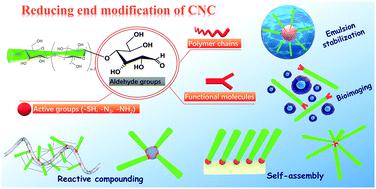当前位置:
X-MOL 学术
›
Nanoscale Horiz.
›
论文详情
Our official English website, www.x-mol.net, welcomes your
feedback! (Note: you will need to create a separate account there.)
Reducing end modification on cellulose nanocrystals: strategy, characterization, applications and challenges.
Nanoscale Horizons ( IF 8.0 ) Pub Date : 2020-01-31 , DOI: 10.1039/d0nh00016g Han Tao 1 , Nathalie Lavoine 2 , Feng Jiang 3 , Juntao Tang 4 , Ning Lin 1
Nanoscale Horizons ( IF 8.0 ) Pub Date : 2020-01-31 , DOI: 10.1039/d0nh00016g Han Tao 1 , Nathalie Lavoine 2 , Feng Jiang 3 , Juntao Tang 4 , Ning Lin 1
Affiliation

|
Different from traditional chemical surface modification, localized modification of the reducing end groups of cellulose nanocrystals (CNCs), i.e. the active aldehyde groups, provides new opportunities for diverse functional applications of this renewable nanomaterial without altering its surface chemistry and properties. Numerous reviews have deeply discussed the surface modification of the hydroxyl groups of CNCs, but no critical comment has been reported on the reducing end modification approach. This review is a comprehensive summary on the modification of the CNC reducing end, presenting the reaction mechanisms and conditions, discussing the different chemical modification strategies and characterization techniques, potential applications and future challenges in this field. In addition, the comparison between surface and end modification strategies of CNCs will highlight the potential of reducing end-functionalized CNCs to be used in various applications as an alternative to traditional surface-modified CNCs, or as additional functional nanoparticles for the design of advanced functional materials.
中文翻译:

减少纤维素纳米晶体的末端修饰:策略,表征,应用和挑战。
与传统的化学表面改性不同,纤维素纳米晶体(CNC)还原端基(即活性醛基)的局部改性为这种可再生纳米材料的各种功能应用提供了新的机会,而不会改变其表面化学性质和特性。许多评论已经深入讨论了CNC分子的羟基表面改性,但没有关于还原端改性方法的批评评论。这篇综述是关于CNC还原端修饰的全面总结,介绍了反应机理和条件,讨论了该领域中不同的化学修饰策略和表征技术,潜在的应用以及未来的挑战。此外,
更新日期:2020-01-31
中文翻译:

减少纤维素纳米晶体的末端修饰:策略,表征,应用和挑战。
与传统的化学表面改性不同,纤维素纳米晶体(CNC)还原端基(即活性醛基)的局部改性为这种可再生纳米材料的各种功能应用提供了新的机会,而不会改变其表面化学性质和特性。许多评论已经深入讨论了CNC分子的羟基表面改性,但没有关于还原端改性方法的批评评论。这篇综述是关于CNC还原端修饰的全面总结,介绍了反应机理和条件,讨论了该领域中不同的化学修饰策略和表征技术,潜在的应用以及未来的挑战。此外,











































 京公网安备 11010802027423号
京公网安备 11010802027423号